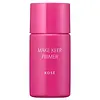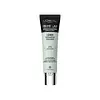What's inside
What's inside
 Key Ingredients
Key Ingredients

 Benefits
Benefits

 Concerns
Concerns

 Ingredients Side-by-side
Ingredients Side-by-side

Water
Skin ConditioningCyclomethicone
EmollientAlcohol Denat.
AntimicrobialTalc
AbrasiveSilica
AbrasiveDimethicone
EmollientDimethicone Crosspolymer
Emulsion StabilisingVinyl Dimethicone/Methicone Silsesquioxane Crosspolymer
PEG-9 Dimethicone
Skin ConditioningPEG-9 Polydimethylsiloxyethyl Dimethicone
EmulsifyingSodium Acetylated Hyaluronate
HumectantTocopherol
AntioxidantSodium Hyaluronate
HumectantProline
Skin ConditioningHydrolyzed Hyaluronic Acid
HumectantButylene Glycol
HumectantEthylhexyl Acrylate
Squalane
EmollientStearic Acid
CleansingTriethoxycaprylylsilane
Trimethylsiloxysilicate
EmollientWater, Cyclomethicone, Alcohol Denat., Talc, Silica, Dimethicone, Dimethicone Crosspolymer, Vinyl Dimethicone/Methicone Silsesquioxane Crosspolymer, PEG-9 Dimethicone, PEG-9 Polydimethylsiloxyethyl Dimethicone, Sodium Acetylated Hyaluronate, Tocopherol, Sodium Hyaluronate, Proline, Hydrolyzed Hyaluronic Acid, Butylene Glycol, Ethylhexyl Acrylate, Squalane, Stearic Acid, Triethoxycaprylylsilane, Trimethylsiloxysilicate
Water
Skin ConditioningIsododecane
EmollientDimethicone
EmollientAlcohol Denat.
AntimicrobialTrimethylsiloxysilicate
EmollientButylene Glycol
HumectantGlycerin
HumectantNiacinamide
SmoothingPEG-10 Dimethicone
Skin ConditioningPerlite
AbsorbentCalcium Aluminum Borosilicate
Silica
AbrasiveIsopropyl Lauroyl Sarcosinate
Skin ConditioningDiisopropyl Sebacate
EmollientDisteardimonium Hectorite
StabilisingBis-PEG/PPG-14/14 Dimethicone
EmollientMagnesium Sulfate
Phenoxyethanol
PreservativeSynthetic Fluorphlogopite
Dipentaerythrityl Tetrahydroxystearate/Tetraisostearate
Skin ConditioningSilica Silylate
EmollientDisodium Stearoyl Glutamate
CleansingTocopherol
AntioxidantParfum
MaskingAluminum Hydroxide
EmollientLinalool
PerfumingLimonene
PerfumingGeraniol
PerfumingCitronellol
PerfumingCI 77891
Cosmetic ColorantCI 77491
Cosmetic ColorantCI 77492
Cosmetic ColorantCI 77499
Cosmetic ColorantCI 77288
Cosmetic ColorantCI 77163
Cosmetic ColorantMica
Cosmetic ColorantWater, Isododecane, Dimethicone, Alcohol Denat., Trimethylsiloxysilicate, Butylene Glycol, Glycerin, Niacinamide, PEG-10 Dimethicone, Perlite, Calcium Aluminum Borosilicate, Silica, Isopropyl Lauroyl Sarcosinate, Diisopropyl Sebacate, Disteardimonium Hectorite, Bis-PEG/PPG-14/14 Dimethicone, Magnesium Sulfate, Phenoxyethanol, Synthetic Fluorphlogopite, Dipentaerythrityl Tetrahydroxystearate/Tetraisostearate, Silica Silylate, Disodium Stearoyl Glutamate, Tocopherol, Parfum, Aluminum Hydroxide, Linalool, Limonene, Geraniol, Citronellol, CI 77891, CI 77491, CI 77492, CI 77499, CI 77288, CI 77163, Mica
Ingredients Explained
These ingredients are found in both products.
Ingredients higher up in an ingredient list are typically present in a larger amount.
Alcohol Denat. is an alcohol with a denaturant property. It is created by mixing ethanol with other additives.
This ingredient gets a bad rep because it is irritating and drying - mostly due to its astringent property. Astringents draw out natural oils in tissue, constricting pores and leaving your skin dried out.
However, alcohol denat. is not all that bad.
Due to its low molecular weight, alcohol denat. tends to evaporate quickly. One study on pig skin found half of applied alcohol evaporated in 10 seconds and less than 3% stayed on skin.
This also helps other ingredients become better absorbed upon application.
Studies are conflicted about whether this ingredient causes skin dehydration. One study from 2005 found adding emollients to propanol-based sanitizer decreased skin dryness and irritation. Another study found irritation only occurs if your skin is already damaged.
Small amounts of alcohol are generally tolerated by oily skin or people who live in humid environments.
The rule of thumb is if this alcohol is near the end of an ingredients list, it will probably not affect your skin much.
Also...
This ingredient has antimicrobial and solvent properties.
The antimicrobial property helps preserve products and increase their shelf life. As a solvent, it helps dissolve other ingredients.
Other types of astringent alcohols include:
Learn more about Alcohol Denat.Butylene Glycol (or BG) is used within cosmetic products for a few different reasons:
Overall, Butylene Glycol is a safe and well-rounded ingredient that works well with other ingredients.
Though this ingredient works well with most skin types, some people with sensitive skin may experience a reaction such as allergic rashes, closed comedones, or itchiness.
Learn more about Butylene GlycolDimethicone is a type of synthetic silicone created from natural materials such as quartz.
What it does:
Dimethicone comes in different viscosities:
Depending on the viscosity, dimethicone has different properties.
Ingredients lists don't always show which type is used, so we recommend reaching out to the brand if you have questions about the viscosity.
This ingredient is unlikely to cause irritation because it does not get absorbed into skin. However, people with silicone allergies should be careful about using this ingredient.
Note: Dimethicone may contribute to pilling. This is because it is not oil or water soluble, so pilling may occur when layered with products. When mixed with heavy oils in a formula, the outcome is also quite greasy.
Learn more about DimethiconeSilica, also known as silicon dioxide, is a naturally occurring mineral. It is used as a fine, spherical, and porous powder in cosmetics.
Though it has exfoliant properties, the function of silica varies depending on the product.
The unique structure of silica enhances the spreadability and adds smoothness, making it a great texture enhancer.
It is also used as an active carrier, emulsifier, and mattifier due to its ability to absorb excess oil.
In some products, tiny microneedles called spicules are made from silica or hydrolyzed sponge. When you rub them in, they lightly polish away dead skin layers and enhance the penetration of active ingredients.
Learn more about SilicaTocopherol (also known as Vitamin E) is a common antioxidant used to help protect the skin from free-radicals and strengthen the skin barrier. It's also fat soluble - this means our skin is great at absorbing it.
Vitamin E also helps keep your natural skin lipids healthy. Your lipid skin barrier naturally consists of lipids, ceramides, and fatty acids. Vitamin E offers extra protection for your skin’s lipid barrier, keeping your skin healthy and nourished.
Another benefit is a bit of UV protection. Vitamin E helps reduce the damage caused by UVB rays. (It should not replace your sunscreen). Combining it with Vitamin C can decrease sunburned cells and hyperpigmentation after UV exposure.
You might have noticed Vitamin E + C often paired together. This is because it is great at stabilizing Vitamin C. Using the two together helps increase the effectiveness of both ingredients.
There are often claims that Vitamin E can reduce/prevent scarring, but these claims haven't been confirmed by scientific research.
Learn more about TocopherolThis silicone is an emollient. Emollients create a thin film on the skin to prevent moisture from escaping.
It is not soluble in water and helps increase water-resistance in products.
According to a manufacturer, it can blend seamlessly with silicone oils, such as Cyclopentasiloxane.
Learn more about TrimethylsiloxysilicateWater. It's the most common cosmetic ingredient of all. You'll usually see it at the top of ingredient lists, meaning that it makes up the largest part of the product.
So why is it so popular? Water most often acts as a solvent - this means that it helps dissolve other ingredients into the formulation.
You'll also recognize water as that liquid we all need to stay alive. If you see this, drink a glass of water. Stay hydrated!
Learn more about Water